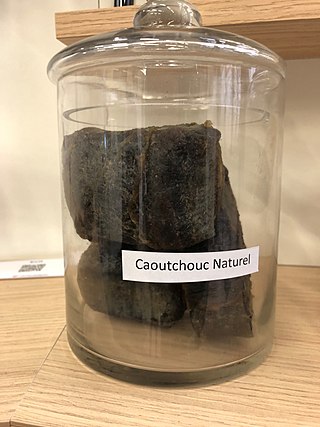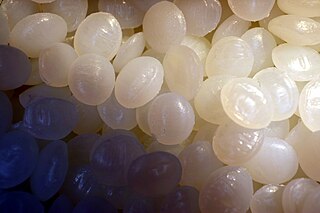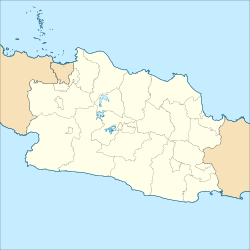
Rubber, also called India rubber, latex, Amazonian rubber, caucho, or caoutchouc, as initially produced, consists of polymers of the organic compound isoprene, with minor impurities of other organic compounds. Thailand, Malaysia, Indonesia, and Cambodia are four of the leading rubber producers.

Gutta-percha is a tree of the genus Palaquium in the family Sapotaceae. The name also refers to the rigid, naturally biologically inert, resilient, electrically nonconductive, thermoplastic latex derived from the tree, particularly from Palaquium gutta; it is a polymer of isoprene which forms a rubber-like elastomer.

A stopper, bung, or cork is a cylindrical or conical closure used to seal a container, such as a bottle, tube, or barrel.

Eucommia ulmoides is a species of small tree native to China. It belongs to the monotypic family Eucommiaceae. It is considered vulnerable in the wild, but is widely cultivated in China for its bark and is highly valued in herbology such as traditional Chinese medicine.

The Putumayo River or Içá River is one of the tributaries of the Amazon River, southwest of and parallel to the Japurá River.

Polycaprolactone (PCL) is a synthetic, semi-crystalline, biodegradable polyester with a melting point of about 60 °C and a glass transition temperature of about −60 °C. The most common use of polycaprolactone is in the production of speciality polyurethanes. Polycaprolactones impart good resistance to water, oil, solvent and chlorine to the polyurethane produced.

Polyisoprene is strictly speaking a collective name for polymers that are produced by polymerization of isoprene. In practice polyisoprene is commonly used to refer to synthetic cis-1,4-polyisoprene, made by the industrial polymerisation of isoprene. Natural forms of polyisoprene are also used in substantial quantities, the most important being "natural rubber", which is derived from the sap of trees. Both synthetic polyisoprene and natural rubber are highly elastic and consequently used to make tires and a variety of other applications.

William "Turkey" Smart was a champion speed skater and the first of a dynasty of skaters from the small village of Welney, on the Norfolk/Cambridgeshire border in the centre of the Fens, England.

Agriculture in Indonesia is one of the key sectors within the Indonesian economy. In the last 50 years, the sector's share in national gross domestic product has decreased considerably, due to the rise of industrialisation and service sector. Nevertheless, for the majority of Indonesian households, farming and plantation remains as a vital income generator. In 2013, the agricultural sector contributed 14.43% to national GDP, a slight decline from 2003's contribution which was 15.19%. In 2012, the agricultural sector provides jobs to approximately 49 million Indonesians, representing 41% of the country's total labor force.
Moynat is a Parisian trunkmaker, founded in Paris in 1849 by Octavie and François Coulembier. They collaborated with a specialist in travel goods, named Pauline Moynat, to open the company's first store at Avenue de l'Opera. The house is notable for its innovations in making trunks lighter and waterproof, and for its participation in the various World's Fairs.
Penfold Golf Ltd. is a British sporting goods manufacturer of golf equipment founded in 1929 by Albert Ernest Penfold (1884–1941). Golf equipment include balls, tees, gloves, apart from fashion accessories such as hats and wallets.

Eucommia is a genus of small trees now native to China, with a fossil record that shows a much wider distribution. The single living species, Eucommia ulmoides, is near threatened in the wild, but is widely cultivated in China for its bark, and is highly valued in herbology such as traditional Chinese medicine.

Palaquium gutta is a tree in the family Sapotaceae. The specific epithet gutta is from the Malay word getah meaning "sap or latex". It is known in Indonesia as karet oblong.
Payena acuminata is a tree in the family Sapotaceae. The specific epithet acuminata means "tapering to a narrow point", referring to the leaf apex.

Henarathgoda Botanical Garden, also known as Gampaha Botanical Garden, is one of the six botanical gardens in Sri Lanka. The botanical garden is situated on the Gampaha-Minuwangoda main road, approximately 450 m (1,480 ft) away from Gampaha railway station. It is about 29 km (18 mi) from Sri Lanka's commercial capital of Colombo.
Miyazaki Maru (宮崎丸) was an 8,520-ton Japanese ocean liner built in 1909 by Kawasaki Dockyard Co., Ltd. in Kobe. While steaming from Yokohama, Japan, to London during World War I, she was sunk in the Atlantic Ocean 150 miles (240 km) to the west of the Isles of Scilly on 31 May 1917 by the Imperial German Navy submarine U-88, with the loss of eight lives.

William Montgomerie (1797–1856) was a Scottish military doctor with the East India Company, and later head of the medical department at Singapore. He is best known for promoting the use of gutta-percha in Europe. This material was an important natural rubber that made submarine telegraph cables possible. Montgomerie was involved in spice cultivation as head of the Singapore botanical experimental gardens and at his personal estate in Singapore. The latter never became economically viable, but he received a Society of Arts gold medal for nutmeg cultivation. He was also responsible for building the first lunatic asylum in Singapore. Montgomerie died at Barrackpore in India a few years after taking part in the Second Anglo-Burmese War as Superintendent Surgeon.

The India Rubber, Gutta Percha and Telegraph Works Company was a London-based company based in Silvertown, East London. It was founded by Stephen William Silver in March 1864 as Silver's Indiarubber Works and Telegraph Cable Company Ltd. However in July that year the name was changed to the India Rubber, Gutta Percha and Telegraph Works Company.
The Submarine Telegraph Company was a British company which laid and operated submarine telegraph cables.

The Gutta Percha Company was an English company formed in 1845 to make a variety of products from the recently introduced natural rubber gutta-percha. Unlike other natural rubbers, this material was thermoplastic allowing it to be easily moulded. Nothing else like it was available to manufacturing until well into the twentieth century when synthetic plastics were developed.















